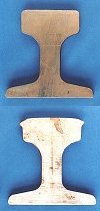|
|
|
As an alternative for lock gates, equipped with wheels running on rails,
the latest idea is to make the gate move to and fro on a very thin film of
water, squeezed between the lock gate and a smooth plastic threshold. The system is due to be used for the first time ever in the "Oranje" locks in the river IJ in Amsterdam which is completed in 1995. A wear-resistant opening and closing mechanism which will need practically no maintenance is realised. For the "Oranje" locks two circularly shaped hydrostatic bearing have been constructed under the 25 m wide lock gate. One of them is visible in the picture below.
Each bearing carry a load of 25 tonnes (250 kN) on a water film of 0.1 mm thickness. Because the bearing diameter has a diameter of 750 mm, the sliding surface must be very smooth.
A pressure of 16 bar and a pump capacity of 2.3 kW each bearing is sufficient (calculator>>). Note that this is about the power consumed by a standard hair dryer. Small irregularities within the diameter of the bearing surface may result in partial mechanical contact. Although these irregularities are flattened out by wear after a number of passages of the lock gate, a very smooth slide surface is still required. In future work flexible bearing surfaces will be applied to make this smoothness less critical. During the Rijkswaterstaat (Dutch public works) / TU Delft project 'Hydrofoot' the circular so-called 'hydrofoot' was developed and applied in the new Prins Willem-Alexander lock in Amsterdam. This concept has proven to be an excellent solution for supporting lock gates. In a follow up-project 'Hydrocontact' the design of the hydrofoot has been improved with respect to its self aligning capability. A much thinner sliding surface has been designed which is capable to smooth contact pressures when incidental contact might take place. Computer programs based on finite element calculations have been
developed to simulate the
bearing behaviour under conditions of hydrostatic lubrication, local
contact and elastic
deflection of the slide surface of the bearing. Demands with respect to
the flatness of the threshold will be less critical in future designs. |
| Conventional lock gate with wheels running on rails. |
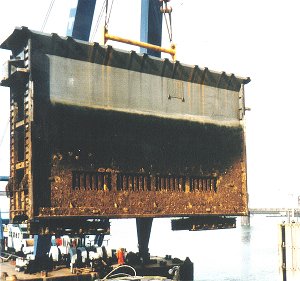
As a result of highly concentrated line contacts the rails show large
plastic deformation (ratcheting). The rail concept requires frequent
inspections and high maintenance costs. The innovative design based on
hydrostatic lubrication has proven to be a maintenance free solution. |
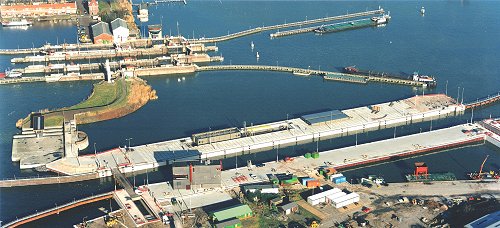
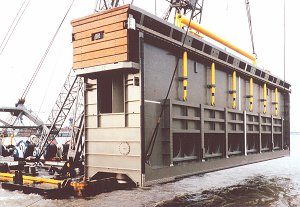
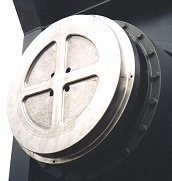 To achieve a uniform film thickness even if the gate is askew, the 100
mm thick bearing surface containing four water chambers is supported by a
rubber ring. With a tilted bearing surface an asymmetrical film pressure
builds up and forces the rubber support to maintain an uniform film
thickness.
To achieve a uniform film thickness even if the gate is askew, the 100
mm thick bearing surface containing four water chambers is supported by a
rubber ring. With a tilted bearing surface an asymmetrical film pressure
builds up and forces the rubber support to maintain an uniform film
thickness.